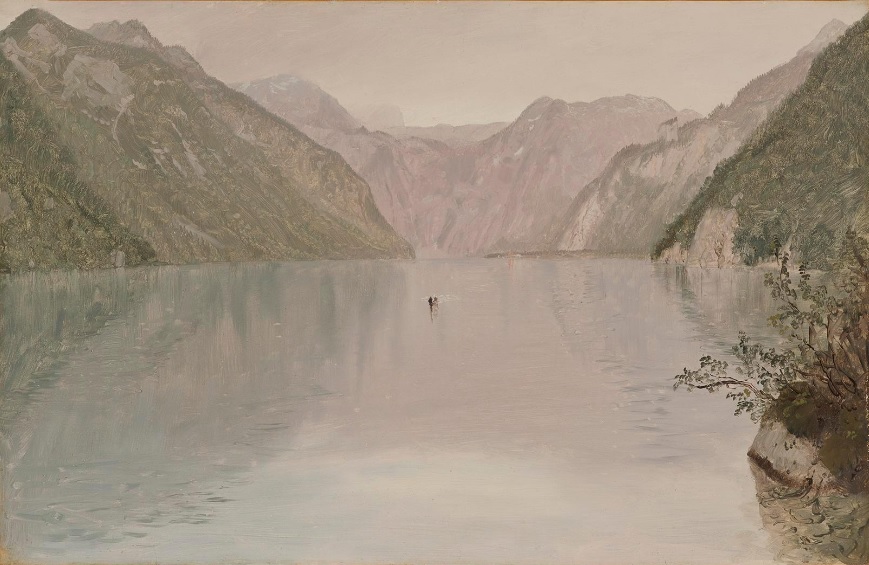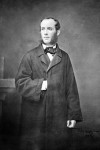
Frederic Edwin Church
American, 1826-1900
Königssee, 1868 ca.
oil on paper mounted on canvas
13 1/8 x 20 in.
SBMA, Gift of Mrs. Lockwood de Forest
1984.53.4

Photo of Frederick E. Church dating between 1855 and 1865 from the Library of Congress.
“I will now speak of another component of scenery, without which every landscape is defective--it is water. Like the eye in the human countenance, it is a most expressive feature: in the unrippled lake, which mirrors all surrounding objects, we have the expression of tranquility and peace--in the rapid stream, the headlong cataract, that of turbulence and impetuosity.” – Thomas Cole, “Essay on American Scenery”, American Monthly Magazine, January, 1836
RESEARCH PAPER
Bavarian lake, Königssee, is the subject of the eponymous work by the master landscape painter, Fredrick Edwin Church. Though Church was most famous for his monumental landscape paintings (many over six feet in length), this work is more modest in scale, only 13 1/8 x 20 in. “Königssee” also diverges from Church’s characteristic use of dramatic, color-saturated lighting (“Moonrise in Greece” from the SBMA collection is a good example of Church’s typical style).
In “Königssee”, the viewer looks out on a glassy lake bordered by forested mountains. The cliffs in the middle ground seem to dive dramatically into the reflective surface of the water. In the background the grey mountain peaks flirt with the low drifting clouds. Church has brought us to Lake Königssee on an overcast day -- using an array of grey tones to describe the mountains and their reflections in the water. The limited palette creates a calm atmosphere. The setting is decidedly grand and yet the muted colors have created a sense of quiet intimacy within this work.
In the lower left foreground, there are a few ripples on the water which provide an immediacy to the water. Church has not painted the shoreline, removing all visual barriers between us and the water. The result is a more immersive work that draws us into Lake Königssee. We orient ourselves to the space by an outcropping of rock with overhanging bushes in the lower-right foreground. These bushes appear to be approximately at eye level, as if we are standing at the edge of the lake.
The bushes in the foreground jut out over the water and create an implied line that guides our eye to the middle of the lake where a dark speck indicates a boat. The minuteness of the boat causes the viewer to reassess the true magnitude of the scene. In the middle ground, Church uses strong descending diagonal lines of the cliffs and their receding reflections to create a wide hourglass shape. The hourglass focuses our gaze toward the middle of the piece and back to the small boat on its surface -- as if inviting us to imagine ourselves in that small boat floating amidst grand alpine mountains.
This work was painted on paper indicating that this is a less formal composition. With paper being more portable than a framed canvas, this is likely an oil sketch that he painted onsite and later mounted on canvas. In some areas, the brush strokes are very visible, particularly in the greenery of the mountain sides. The brush strokes seem rapid and give a somewhat impressionistic quality. The visible strokes of this work contrast with the artist’s characteristic commitment to depict flora and fauna with “invisible” strokes in almost scientific detail. Church was known to make many sketches of his subjects from different vantage points in different atmospheric conditions. His formal, monumental works are in effect a patchwork of his onsite studies blended into one painting. These works do not particularly portray an actual moment in time or one accurate perspective. Likely this work started out as such a sketch.
Fredric Edwin Church was born in 1826 to a wealthy Hartford family. His father, a jeweler and banker, used his connections to provide his 18-year-old son with instruction from the artist, Thomas Cole. Cole was one of the most admired landscape painters of the day and known as the father of American landscape painting. (Thomas Cole’s painting, “Meeting of the Waters” 1847 may be found in the SBMA collection.) Church studied with Cole from 1844-1846 at Cole’s Catskill studio.
Cole instilled his student with the belief in “a higher style of landscape” that could “speak a language strong, moral and imaginative (Kelly, p.34). Cole’s “Essays on American Scenery” bemoan the perceived indifference of his contemporaries to the beauties of wild nature. It is not surprising, then, that he urges the landscape artist to use imagination and drama to highlight for viewers the lavish “adornments of nature.” (Cole, 1836)
American landscape artists inspired by or connected to Thomas Cole formed a fraternity of artists called the Hudson River School. This collection of New York-based landscape painters was characterized by an idealized naturalism in style. Of Hudson River School of artists, Church and his contemporary Albert Bierstadt became the most acclaimed. Using storms, vibrant light and grand vistas to create drama within a scene, they perfected the “Heroic Landscape” (Avery, 2004)
Church gained notoriety in his own right in 1857 for his monumental work, “Niagara.” Over seven feet wide, this work displays the raw power and drama of Niagara Falls. Unlike previous depictions of Niagara Falls, there is no bank or spit of land to separate us from the surging waters. (Though much less dramatic, “Königssee” uses a similar technique.) Due to its popularity, “Niagara” traveled from Washington D.C. to New York and to the United Kingdom. As the public became familiar with Church’s work, they noted that his sense of naturalism surpassed that of his instructor’s. “… Church's ability to suggest the actual appearance of nature and, especially, his ability to capture with startling clarity the radiant play of light across rocks, water, trees, hills, and clouds, sets his work apart from Cole's.” (Kelly, p.37).
Though Thomas Cole’s influence remained strong throughout Church’s career, there was another man whose ideas both underscored Church’s techniques and much of his subject matter; that was the German naturalist, Alexander Von Humboldt. Humboldt published his book “Cosmos” in the late 1840’s which was a treatise on the nature of the universe. The book is based on his observations from a five year exploration of South America. He noted with detail the flora and fauna on his expedition. He encouraged the young minds of his time, and especially painters, to go to the wild places and carefully document what they saw for the public who would likely never see such wonders for themselves. Humboldt hoped: “The result would be ‘heroic landscape painting’ that made use of the creative imagination and maintained a connection with the great traditions of painting yet was also modern in its scientific accuracy.” (Kelly, p. 47)
Inspired by this charge, Church made a trip Columbia in 1853, followed by many others to scenic wonders around the world. Over the next four years, Church cemented his fame through monumental portrayals of exotic destinations and dramatic vistas. Scenes from the Andes and ephemeral landscapes of icebergs in the North Atlantic captured the public’s imagination.
In 1865, as the American Civil War drew to a close, Church lost both of his young children to diphtheria. This launched a period of frenzied productivity. In 1867 Church, his wife and their newly born son, Frederic Joseph, embarked on a nearly two-year tour of Europe and the Holy Land. “He wished, as usual, to broaden his horizons. But his aspirations were that of a matured, married man still savaged by personal suffering. From Europe, and especially from deep within the Mediterranean historical past, he solicited solace and recovery…” (Carr, p.88).
It was on this trip that he visited Lake Königssee, in late June and early July of 1868. SBMA’s “Königssee” was likely one of over 1,000 sketches he is said to have prepared during his Old-World Tour (Carr, p.88). Church’s time at Lake Königssee came toward the end of his lengthy tour. After documenting the ruins of empires and bustling through Europe’s great cities, one can almost hear a sigh of calm as Church returns his attention to the natural world. Thomas Cole noted the power of still water to express “tranquility and peace” (Cole, 1836); likewise, Church’s image of Lake Königssee is a soothing contrast to the personal and collective turbulence he experienced in the years preceding this journey.
In the following decade, Church’s popularity declined as tastes in landscape painting shifted to the smaller-scale compositions of the French, Barbizon style. Landscape painting as a whole lost favor as collectors became more interested in portraiture and images of human experience. In his mid and later life, Church was afflicted with rheumatoid arthritis, which impaired his ability to paint with the fine detail that characterized his early career.
Though theoretically at odds, Church’s work beautifully combines imagination and scientific description -- both enticing and instructing the viewer. In a time long before the advent of color photography, it is hard to overstate the impact such vibrant portrayals would have had on the viewer. The grand presence of nature is ubiquitous throughout Church’s oeuvre. Even in a comparatively subdued work such as “Königssee” lofty nature is present, but Church allows us to encounter her in repose, without her makeup on.
Prepared for the Santa Barbara Museum of Art Docent Council by Rachel Reddix, Spring 2023
Bibliography
Avery, K. J. (2009, August). Frederic Edwin Church (1826–1900): Essay: The Metropolitan Museum of Art: Heilbrunn timeline of art history. The Met's Heilbrunn Timeline of Art History. Retrieved February 20, 2023
https://www.metmuseum.org/toah/hd/chur/hd_chur.htm
Avery, K. J. (2004, October). The Hudson River School: Essay: The Metropolitan Museum of Art: Heilbrunn timeline of art history. The Met's Heilbrunn Timeline of Art History. Retrieved February 20, 2023
https://www.metmuseum.org/toah/hd/hurs/hd_hurs.htm
Carr, Gerald L. (2000). Church, Frederic Edwin, 1826-1900. Berry-Hill Galleries. New York: Berry-Hill Galleries.
Cole, T. (1836, January). Essay on American Scenery. American Monthly Magazine, 1.
Kelly, F. (1989). Frederic Edwin Church. (F. P. Smyth, Ed.). National Gallery of Art and the Smithsonian Institution Press.
SBMA CURATORIAL LABELS
The naturalist Alexander von Humboldt (1769-1859) contended that landscape paintings, though based in direct observation of nature, must be “fertilized by the powers of the mind” in order to achieve a “grander style of heroic painting.” Perhaps, no other 19th-century American landscape artist realized this ideal more fully than Frederic Edwin Church. In accordance with Humboldt’s recommendations, Church made a point of traveling to Königssee in Bavaria near the Austrian border, in order to capture the wondrous beauty of its glassy Alpine lake, surrounded by massive peaks. Admirers marveled at Church’s unrivaled color memory, as instanced by the accuracy with which he described the rocks, misty peaks, and pristine lake of Königssee.
- Preston Morton Reinstallation, 2022
